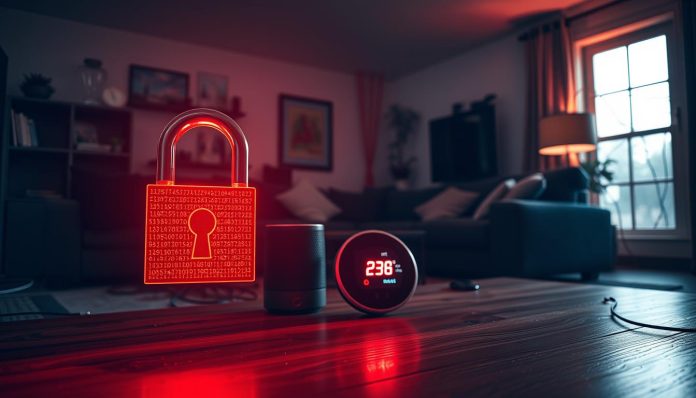You’ve made your home smart, but have you thought about the cyber threats it faces?
Ransomware is a harmful malware. It encrypts your files or locks your systems, making data hard to access. Then, attackers ask for money to unlock your data.
This ransomware attack can harm your smart home security. It puts your personal data at risk. Knowing the threat is the first step to protect your smart home.
Key Takeaways
- Ransomware is a type of malware that encrypts your files or locks your computer systems.
- Cybercriminals demand a ransom in exchange for the decryption key.
- Smart home devices are vulnerable to ransomware attacks.
- Protecting your smart home security is crucial.
- Awareness of cyber threats is key to safeguarding your personal data.
What is Ransomware and How Does It Work?
Ransomware is a type of malware that locks your smart home devices. It demands a ransom to unlock them. This threat is growing, targeting both people and businesses by exploiting device vulnerabilities.
Definition of Ransomware
Ransomware is a malicious software that demands money by encrypting or locking devices. There are two main types: crypto ransomware, which encrypts files, and locker ransomware, which locks devices. Crypto ransomware is more common and can be very damaging, making files inaccessible.
Common Techniques Used
Attackers use phishing emails, exploited vulnerabilities, and malicious downloads to spread ransomware. Once a device is infected, it can spread to other devices in your smart home. Phishing emails are a common way to get infected, as they trick users into downloading harmful attachments or clicking on links.
How Ransomware Spreads
Ransomware can spread through a smart home network in several ways:
- Unpatched vulnerabilities in devices
- Infected software downloads
- Shared networks and connected devices
The following table shows common ransomware attack vectors and how to prevent them:
| Attack Vector | Description | Prevention Method |
|---|---|---|
| Phishing Emails | Malicious emails with attachments or links | Avoid suspicious emails, use antivirus software |
| Exploited Vulnerabilities | Unpatched security flaws in devices or software | Regularly update software and devices |
| Malicious Downloads | Infected software or files downloaded from the internet | Use reputable sources for downloads, scan files for malware |
Knowing how ransomware works and spreads is key to protecting your smart home. By understanding common attack methods and taking preventive steps, you can lower your risk of a ransomware attack.
The Rise of Smart Homes and IoT Devices
Technology has advanced quickly, making smart homes a reality today. They change how we live. With many devices and systems, life gets easier but also riskier.
What is a Smart Home?
A smart home has devices and systems you can control from anywhere. They make your home more comfortable, secure, and save energy. They work together through the Internet of Things (IoT).
Examples of IoT Devices
IoT devices in smart homes include simple things like smart thermostats and lights. They also have complex items like security cameras and voice assistants. Other examples are smart door locks, refrigerators, and entertainment systems.
Benefits of Smart Home Technology
Smart home tech brings many benefits. It makes life easier, saves energy, and boosts security. It automates tasks and lets you monitor your home in real-time, enhancing your life quality.
| Benefits | Description |
|---|---|
| Convenience | Control devices remotely, automate tasks |
| Energy Efficiency | Optimize energy consumption with smart thermostats and lighting |
| Security | Monitor your home with security cameras and smart door locks |
When you use smart home tech, remember the security risks. Ransomware attacks are a big concern. Keeping your IoT devices safe is key to protecting your home.
How Ransomware Targets Smart Home Systems
IoT devices in smart homes bring new risks. Adding more devices means more ways for hackers to get in.
Vulnerabilities in Smart Devices
Smart devices connect to the internet and each other. This creates a network hackers can use. Weak passwords and outdated software are big problems.
| Device Type | Common Vulnerability | Potential Impact |
|---|---|---|
| Smart Thermostats | Weak Passwords | Unauthorized access to temperature control |
| Security Cameras | Outdated Firmware | Video feed compromise |
| Smart Speakers | Lack of Two-Factor Authentication | Unauthorized access to personal data |
Entry Points for Attackers
Attackers find ways into your smart home. They use vulnerable devices and insecure networks. Then, they can harm many devices.
Real-Life Attack Scenarios
Ransomware attacks on smart homes happen in many ways. For example, hackers might block your smart door lock. Or, they might ask for money to stop showing your security camera feed online. Knowing these scenarios helps you protect your home.
By understanding the risks and taking steps to protect your home, you can lower the chance of a ransomware attack.
The Impact of Ransomware on Smart Homes
Ransomware attacks on smart homes cause financial loss, data breaches, and emotional distress. As smart home tech becomes more common, the risks of ransomware attacks grow. This makes the consequences more severe.
Financial Consequences
Ransomware attacks can be very costly for homeowners. The cost of paying ransoms and potential losses from downtime or data loss can be high. There may also be extra costs for fixing or replacing damaged devices.
Financial losses from ransomware can also include the cost of hiring cybersecurity experts. They help mitigate the attack and prevent future ones.
Data Loss and Privacy Breaches
One major worry about ransomware attacks is data loss and privacy breaches. Smart home devices often hold personal info. If this info is stolen, it can lead to identity theft or other bad things.
Homeowners need to protect their data well. Losing personal data can have lasting effects.
Emotional and Psychological Effects
The emotional and psychological effects of ransomware attacks are real. Homeowners may feel stressed, anxious, and vulnerable. This is especially true if their personal data is at risk.
Feeling under attack or losing control over digital space can be psychologically taxing. It shows the importance of good cybersecurity to protect mental health.
Signs Your Smart Home Might Be Under Attack
If you use a smart home, it’s key to watch out for ransomware threats. Knowing the signs of an attack is the first step to protect your home. Ransomware can sneak into your smart home through different weaknesses. Spotting the warning signs early can help you act fast.
Strange Device Behavior
One clear sign of a ransomware attack is odd behavior from your smart devices. This might include devices starting or stopping on their own, not responding, or making weird sounds. If you see these signs, it could mean your smart home is under attack.
Unusual Network Activity
Another sign of trouble is odd network activity. You might see slower internet, strange devices on your network, or odd login attempts on your smart home devices. Keeping an eye on your network can help you spot these problems early.
Ransom Notes or Messages
The most obvious sign of a ransomware attack is getting a ransom note or message. This message will ask for money to get your devices or data back. Homeowners might not know they’ve been hacked right away. But they’ll definitely notice when they’re asked for money. These messages can pop up on screens, in emails, or through smart home interfaces.
Knowing these signs and taking steps to prevent attacks can greatly lower the risk. Keep an eye on your devices and network, and make sure your security is strong. This is key in fighting against ransomware.
Protecting Your Smart Home from Ransomware
Ransomware attacks are getting smarter, so protecting your smart home is key. To keep your home safe, use strong passwords, secure your network, and enable multi-factor authentication. These actions can greatly lower the chance of a ransomware attack.
Regular Software Updates
Keeping your smart home devices’ software up to date is a simple yet powerful way to protect them. Updates often fix security holes that ransomware could use. Enable automatic updates to keep your devices secure with the latest fixes.
Importance of Strong Passwords
Strong, unique passwords are essential for all your smart devices and accounts. Don’t use your name, birthdate, or common words. Choose complex passwords with letters, numbers, and symbols. A password manager can help you keep them safe.
Using Two-Factor Authentication
Two-factor authentication (2FA) adds extra security. It requires a second verification step, like a code or biometric scan, in addition to a password. Enable 2FA on all devices and accounts that support it to boost your security.
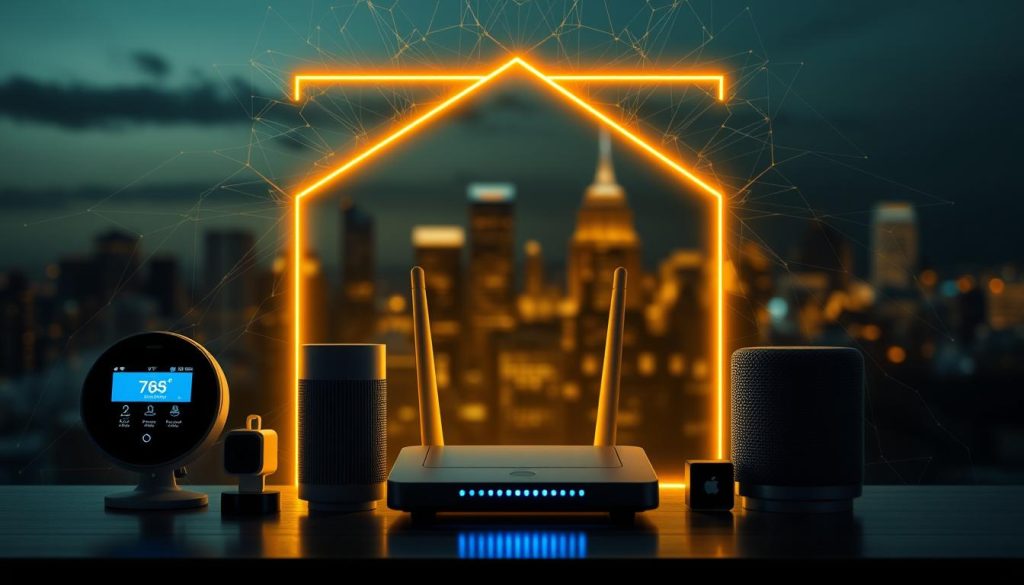
Best Practices for Home Network Security
Smart homes are getting more common, and so is the need for strong network security. Your home network connects all your devices, making it key to keep safe from hackers. It’s vital to protect this network to avoid unauthorized access and cyber threats.
Secure Your Wi-Fi Network
Your Wi-Fi network is your first defense. To keep it safe, do the following:
- Use a strong and unique password for your Wi-Fi network.
- Enable WPA3 encryption, the latest security protocol for Wi-Fi networks.
- Change the default name and password of your router to prevent easy access by hackers.
These steps will greatly lower the chance of your Wi-Fi network being hacked.
Use Firewalls and Antivirus Programs
Firewalls and antivirus programs are crucial for protecting your network. A firewall blocks unwanted internet traffic, while antivirus software finds and removes malware.
Key actions include:
- Enabling the firewall on your router and individual devices.
- Installing reputable antivirus software on all connected devices.
- Regularly updating your firewall and antivirus software to ensure you have the latest protections.
Limit Device Connections
Limiting devices on your network boosts security. Fewer devices mean fewer ways for hackers to get in. Check your network often and remove unused or unknown devices.
Best practices include:
- Regularly auditing your network for connected devices.
- Disconnecting devices that are not in use.
- Setting up a guest network for visitors to limit their access to your main network.
By following these tips, you can make your home network much safer. This protects your smart home devices and the data they handle.
What to Do if You Become a Victim
If you’re hit by a ransomware attack, knowing what to do can help a lot. Ransomware can lock you out of your smart home devices. It demands a ransom to get access back.
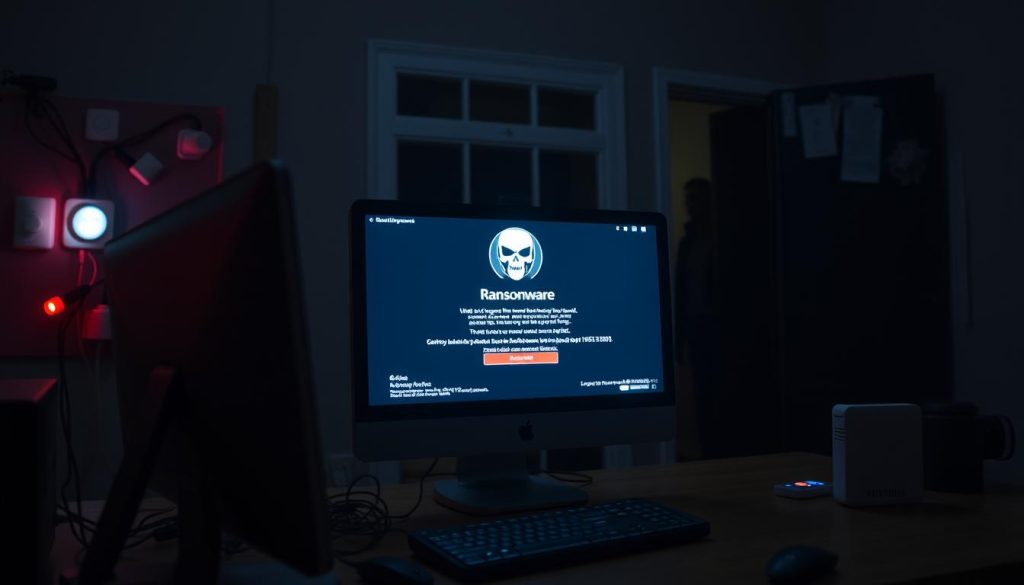
Steps to Take Immediately
Act fast when a ransomware attack happens. Here are the first steps:
- Disconnect affected devices from the network to stop the malware from spreading.
- Don’t pay the ransom. It doesn’t promise your data will be back.
- Find out what kind of ransomware you have. This helps you understand it better.
Reporting the Attack
Telling authorities about a ransomware attack is key. It helps catch the bad guys and might help get your files back. Here’s how to report:
- Call your local police and tell them about the attack.
- Report it to the FBI’s Internet Crime Complaint Center (IC3).
- Tell your internet service provider (ISP) about the attack. They can help.
Professional Help and Recovery Options
Getting help from experts is crucial to recover from a ransomware attack. They can fix your system and keep you safe. Here are some options:
| Service | Description | Benefits |
|---|---|---|
| Cybersecurity Consultants | Experts who check your system’s weak spots and give advice. | Stronger security, less chance of future attacks. |
| Data Recovery Services | Special services that try to get back your data from infected devices. | Getting back important data, less loss. |
| IT Support Teams | Teams that help fix your smart home system and make it safe. | Fast fix of services, expert security tips. |
By acting fast, reporting the attack, and getting professional help, you can handle a ransomware attack on your smart home well.
Ransomware Recovery Strategies for Smart Homes
Getting back from a ransomware attack on your smart home needs a smart plan. This plan helps you fix the damage and get back to normal. It includes several important steps to take back control of your devices and data.
Backing Up Your Data
Backing up your data is very important. Regular backups are your best defense against losing data in a ransomware attack. It’s key to have offline or securely isolated backups to keep your data safe.
To make a strong backup plan, think about these:
- Use external hard drives or cloud storage that aren’t always connected to your network.
- Set up regular backups, like daily or weekly, based on how often your data changes.
- Check your backups often to make sure they’re complete and can be restored well.
Restoring Smart Devices
Fixing your smart devices after a ransomware attack is more than just removing the malware. You must make sure all devices are completely clean before using them again.
To fix your smart devices well:
- Turn off all devices and disconnect them from the network.
- Scan and clean each device with antivirus software.
- Update the firmware and software on each device to the latest versions.
- Reset devices to their factory settings if needed, then reinstall any needed settings or apps.
Learning from the Attack
After getting over a ransomware attack, it’s key to conduct a thorough review. This helps you understand how the attack happened and how to avoid it in the future.
Here are steps to learn from the attack:
- Look into the attack vector to find weak spots in your smart home setup.
- Check your security measures and update them if needed to stop future attacks.
- Teach all household members about cybersecurity and how to avoid threats.
By following these steps, you can make your smart home safer. This reduces the chance of getting hit by ransomware or other cyber threats.
The Role of Cybersecurity in Smart Homes
Smart homes are becoming more common, and cybersecurity is key to protecting them. With more devices connected, homes face new cyber threats.
Cybersecurity now covers more than just computers and phones. It’s about keeping all smart home devices safe. This includes thermostats, lights, cameras, and voice assistants.
Importance of Cybersecurity Education
Learning about cybersecurity is vital for smart home owners. They need to know about risks and how to avoid them. This includes securing Wi-Fi, using strong passwords, and updating devices.
Cybersecurity education helps homeowners protect their homes. By knowing device vulnerabilities, they can make better security choices.
Resources for Homeowners
There are many resources to boost smart home security. These include online guides, blogs, and professional services. They offer advice and protection plans.
- Online tutorials and webinars teach how to secure devices
- Cybersecurity software protects against malware
- Professional services provide personalized security plans
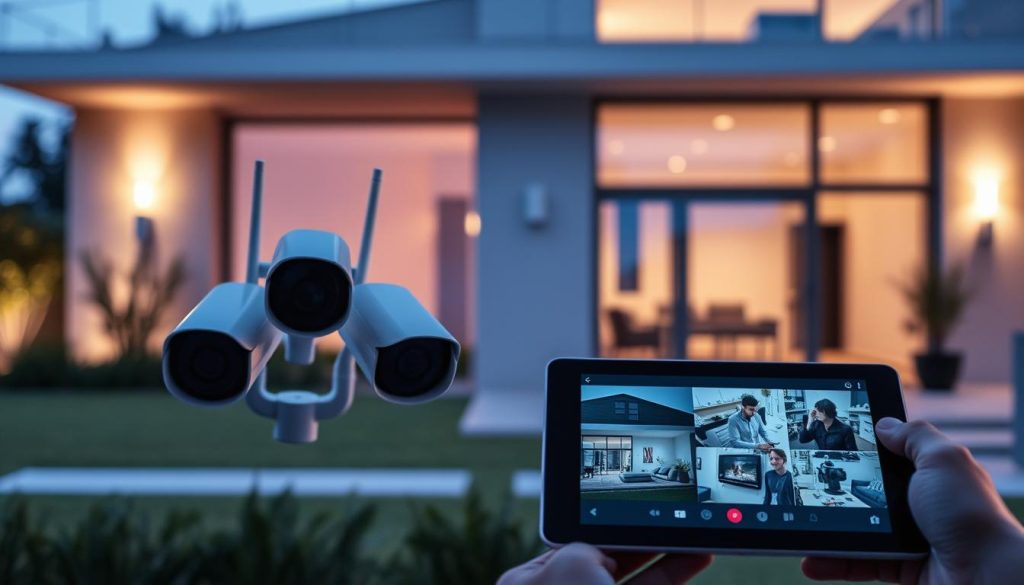
Future Trends in Smart Home Security
Smart home tech is evolving, and so is security. Future security will use AI and machine learning for better threat detection.
The use of AI and machine learning will improve threat detection. This makes it harder for hackers. New security standards will also make homes safer.
By keeping up with these trends, homeowners can keep their smart homes secure.
Legal Implications of Ransomware Attacks
Ransomware threats to smart home devices carry big legal implications for homeowners. It’s key to know the legal side to protect your smart home. As ransomware attacks get smarter, understanding the law is vital.
Cybercrime Laws and Regulations
Cybercrime laws differ by state but usually cover hacking, data theft, and disrupting computer services. Knowing these laws helps you understand your rights and duties. For example, the Computer Fraud and Abuse Act (CFAA) is a federal law against unauthorized computer access.
Reporting Obligations for Homeowners
If you face a ransomware attack, you might need to report it to the police. The type of attack and data lost determines reporting needs. If your smart home has personal info, you must tell the data protection authorities. Know your state’s reporting rules to follow the law.
Liability Issues with Smart Devices
Liability for ransomware attacks can be tricky, involving many parties. If a device’s flaw led to the attack, the maker might be to blame. But, if you didn’t update or used weak passwords, you could be seen as negligent. Knowing these issues helps you avoid risks.
To avoid legal trouble, secure your smart home devices well. Keep software up to date, use strong passwords, and enable two-factor authentication. Being informed and careful can keep your smart home safe and legal.
The Future of Ransomware in Smart Homes
Ransomware in smart homes is a growing worry. New weaknesses appear as tech gets better. Smart homes are becoming a bigger target for hackers.
New Challenges on the Horizon
New ransomware attacks are coming. Attackers are getting smarter, targeting many devices at once. They use tricks like social engineering to get your data.
Here are some threats to watch out for:
- Ransomware made just for smart home gadgets
- AI-powered attacks to make them more effective
- More complex ways to get into your system
Advances in Security Measures
Security tech is getting better too. Artificial intelligence and machine learning help fight ransomware better.
| Security Measure | Description | Benefit |
|---|---|---|
| AI-Powered Threat Detection | Uses machine learning to spot threats early | Prevents ransomware attacks |
| Regular Software Updates | Keeps devices safe with the latest fixes | Protects against known attacks |
| Two-Factor Authentication | Requires more than just a password to log in | Makes it harder for hackers to get in |
Staying Ahead of the Threats
Homeowners need to keep up with security news. Being proactive helps keep your smart home safe from ransomware.
Here’s what you can do:
- Always update your devices and software
- Use strong, different passwords for everything
- Watch your network for anything odd
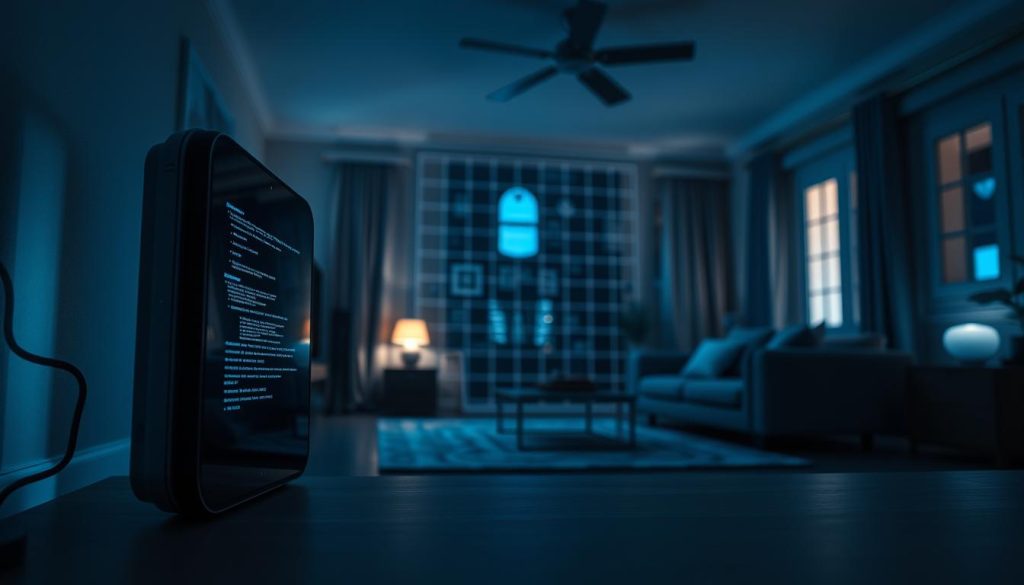
By knowing about new threats and security tech, you can protect your smart home. Stay ahead of ransomware.
Conclusion: Staying Safe in Your Smart Home
Smart home tech keeps getting better, but we must stay alert to threats. To keep your home safe, be watchful, keep learning, and update your security as needed.
Vigilance is Key
Keep an eye on your devices and network. This helps catch security issues early. Be careful with links and downloads, and make sure your devices are secure.
Staying Informed
Learning is key in the fast-changing world of cyber security. Keep up with security updates and learn about new threats. This helps you protect your smart home.
Adapting to Emerging Threats
New tech brings new dangers. Stay informed and update your security to fight off threats like ransomware. Being proactive keeps your smart home safe and enjoyable.
